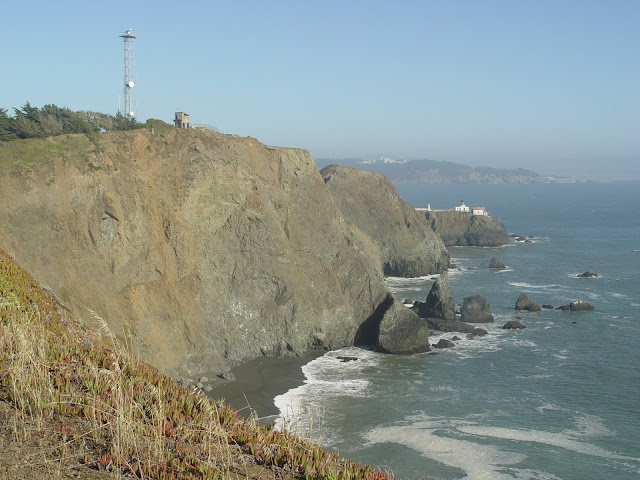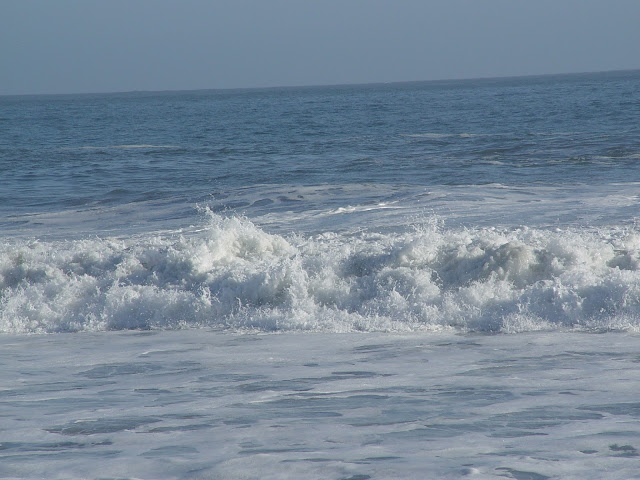Different Names For The Same Thing
SFcam: 2010: Part One
(June 27, 2010)
To my misfortune, my trip to San Francisco allowed only one visit to the Golden Gate Bridge, and that happened to be during the night. To any amateur photographer, this becomes a living nightmare. Light is your greatest ally and your worst foe in any situation: it can make a photograph blurry and distorted, reduce the usefulness of flash, and even taint the colors of nature, but the lack of daylight altogether can be very devious and misleading. Your eyes may have adjusted to the dark conditions of the night, (light may even be present in the form of stars, the moon or city lights) but your camera will not. Consider the following picture:
What is this you may ask? Why this is the Golden Gate Bridge, couldn't you tell? Of course you couldn't because there isn't enough light.
The first delightful discovery of my new camera was its ominous "night vision mode." The photographs never came out crisp and clean, but they did do a better job at capturing the subject than any camera without the feature. I personally think the grainy filter gives everything an artistic edge, but others might argue it just has poor quality.
The second delightful discovery was the quality of my close-up shots. I had never been able to previously master the art of "micro photography," and while I could never go microscopic, it became obvious that this was the new camera's greatest strength. The hostel at which we stayed featured an open array of hills surrounded by trees and the ocean just a bit west, and I did a bit of venturing out into the fields to test the quality of my photographs, which we can confirm with the dandelion above. You might also notice the raccoon a few photographs back. That little critter did a bit of scavenging near the hostel with the staff fully aware of its presence. I guess it became a sort of landmark for the establishment.
The hostel didn't harbor anything else particularly special besides the post-apocalyptic basketball court lay strewn across the meadows and so my family took the liberty of visiting the great cliffs and beaches of the bay. It was here that I learned the majority of my camera's limitations with focus and zoom. I learned that even very minor zooming of the lens can drastically alter the quality of the photographs. I also learned that no camera was invincible and there was such a thing as a bad picture, even with something as great as mine. To my delight, I discovered that motion was something that the camera specialized in. The photograph you see above would have been impossible with Newcam, but I managed to capture the perfect moment of the waves crashing against the rocks.
During the passing time, I began constructing possible names for the new camera. Silvercam, Elitecam; names that sound sophisticated and interesting. Oddly enough, I dubbed the new addition to my *ahem* "family" as the magnificent "SFcam," a decision that I still regret to this day. I could have given it any sort of fantastical name that represented its true potential, but my trip to San Francisco was so memorable that I went on a whim and decided to name it after an abbreviation of a city I visited once. Granted, San Francisco would forever hold a special place in my heart as a sentimental landmark, but everyday it becomes increasingly clear to me that I chose poorly.
(June 27, 2010)
To my misfortune, my trip to San Francisco allowed only one visit to the Golden Gate Bridge, and that happened to be during the night. To any amateur photographer, this becomes a living nightmare. Light is your greatest ally and your worst foe in any situation: it can make a photograph blurry and distorted, reduce the usefulness of flash, and even taint the colors of nature, but the lack of daylight altogether can be very devious and misleading. Your eyes may have adjusted to the dark conditions of the night, (light may even be present in the form of stars, the moon or city lights) but your camera will not. Consider the following picture:
What is this you may ask? Why this is the Golden Gate Bridge, couldn't you tell? Of course you couldn't because there isn't enough light.
The first delightful discovery of my new camera was its ominous "night vision mode." The photographs never came out crisp and clean, but they did do a better job at capturing the subject than any camera without the feature. I personally think the grainy filter gives everything an artistic edge, but others might argue it just has poor quality.
The second delightful discovery was the quality of my close-up shots. I had never been able to previously master the art of "micro photography," and while I could never go microscopic, it became obvious that this was the new camera's greatest strength. The hostel at which we stayed featured an open array of hills surrounded by trees and the ocean just a bit west, and I did a bit of venturing out into the fields to test the quality of my photographs, which we can confirm with the dandelion above. You might also notice the raccoon a few photographs back. That little critter did a bit of scavenging near the hostel with the staff fully aware of its presence. I guess it became a sort of landmark for the establishment.
The hostel didn't harbor anything else particularly special besides the post-apocalyptic basketball court lay strewn across the meadows and so my family took the liberty of visiting the great cliffs and beaches of the bay. It was here that I learned the majority of my camera's limitations with focus and zoom. I learned that even very minor zooming of the lens can drastically alter the quality of the photographs. I also learned that no camera was invincible and there was such a thing as a bad picture, even with something as great as mine. To my delight, I discovered that motion was something that the camera specialized in. The photograph you see above would have been impossible with Newcam, but I managed to capture the perfect moment of the waves crashing against the rocks.
During the passing time, I began constructing possible names for the new camera. Silvercam, Elitecam; names that sound sophisticated and interesting. Oddly enough, I dubbed the new addition to my *ahem* "family" as the magnificent "SFcam," a decision that I still regret to this day. I could have given it any sort of fantastical name that represented its true potential, but my trip to San Francisco was so memorable that I went on a whim and decided to name it after an abbreviation of a city I visited once. Granted, San Francisco would forever hold a special place in my heart as a sentimental landmark, but everyday it becomes increasingly clear to me that I chose poorly.


























Comments
Post a Comment